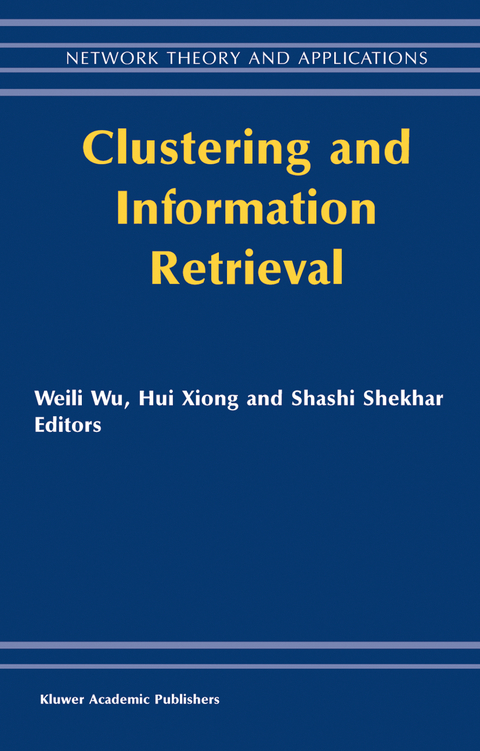
Clustering and Information Retrieval
Seiten
2011
|
Softcover reprint of the original 1st ed. 2004
Springer-Verlag New York Inc.
978-1-4613-7949-2 (ISBN)
Springer-Verlag New York Inc.
978-1-4613-7949-2 (ISBN)
Clustering is an important technique for discovering relatively dense sub-regions or sub-spaces of a multi-dimension data distribution. describes a clustering method for a general metric space which is a common model of data relevant to information retrieval.
Clustering is an important technique for discovering relatively dense sub-regions or sub-spaces of a multi-dimension data distribution. Clus tering has been used in information retrieval for many different purposes, such as query expansion, document grouping, document indexing, and visualization of search results. In this book, we address issues of cluster ing algorithms, evaluation methodologies, applications, and architectures for information retrieval. The first two chapters discuss clustering algorithms. The chapter from Baeza-Yates et al. describes a clustering method for a general metric space which is a common model of data relevant to information retrieval. The chapter by Guha, Rastogi, and Shim presents a survey as well as detailed discussion of two clustering algorithms: CURE and ROCK for numeric data and categorical data respectively. Evaluation methodologies are addressed in the next two chapters. Ertoz et al. demonstrate the use of text retrieval benchmarks, such as TRECS, to evaluate clustering algorithms. He et al. provide objective measures of clustering quality in their chapter. Applications of clustering methods to information retrieval is ad dressed in the next four chapters. Chu et al. and Noel et al. explore feature selection using word stems, phrases, and link associations for document clustering and indexing. Wen et al. and Sung et al. discuss applications of clustering to user queries and data cleansing. Finally, we consider the problem of designing architectures for infor mation retrieval. Crichton, Hughes, and Kelly elaborate on the devel opment of a scientific data system architecture for information retrieval.
Clustering is an important technique for discovering relatively dense sub-regions or sub-spaces of a multi-dimension data distribution. Clus tering has been used in information retrieval for many different purposes, such as query expansion, document grouping, document indexing, and visualization of search results. In this book, we address issues of cluster ing algorithms, evaluation methodologies, applications, and architectures for information retrieval. The first two chapters discuss clustering algorithms. The chapter from Baeza-Yates et al. describes a clustering method for a general metric space which is a common model of data relevant to information retrieval. The chapter by Guha, Rastogi, and Shim presents a survey as well as detailed discussion of two clustering algorithms: CURE and ROCK for numeric data and categorical data respectively. Evaluation methodologies are addressed in the next two chapters. Ertoz et al. demonstrate the use of text retrieval benchmarks, such as TRECS, to evaluate clustering algorithms. He et al. provide objective measures of clustering quality in their chapter. Applications of clustering methods to information retrieval is ad dressed in the next four chapters. Chu et al. and Noel et al. explore feature selection using word stems, phrases, and link associations for document clustering and indexing. Wen et al. and Sung et al. discuss applications of clustering to user queries and data cleansing. Finally, we consider the problem of designing architectures for infor mation retrieval. Crichton, Hughes, and Kelly elaborate on the devel opment of a scientific data system architecture for information retrieval.
Clustering in Metric Spaces with Applications to Information Retrieval.- Techniques for Clustering Massive Data Sets.- Finding Topics in Collections of Documents: A Shared Nearest Neighbor Approach.- On Quantitative Evaluation of Clustering Systems.- Techniques for Textual Document Indexing and Retrieval via Knowledge Sources and Data Mining.- Document Clustering, Visualization, and Retrieval via Link Mining.- Query Clustering in the Web Context.- Clustering Techniques for Large Database Cleansing.- A Science Data System Architecture for Information Retrieval.- Granular Computing for the Design of Information Retrieval Support Systems.
| Reihe/Serie | Network Theory and Applications ; 11 |
|---|---|
| Zusatzinfo | VIII, 330 p. |
| Verlagsort | New York, NY |
| Sprache | englisch |
| Maße | 155 x 235 mm |
| Themenwelt | Mathematik / Informatik ► Informatik ► Datenbanken |
| Informatik ► Theorie / Studium ► Algorithmen | |
| Informatik ► Theorie / Studium ► Künstliche Intelligenz / Robotik | |
| ISBN-10 | 1-4613-7949-0 / 1461379490 |
| ISBN-13 | 978-1-4613-7949-2 / 9781461379492 |
| Zustand | Neuware |
| Haben Sie eine Frage zum Produkt? |
Mehr entdecken
aus dem Bereich
aus dem Bereich
Buch | Softcover (2024)
Lehmanns Media (Verlag)
CHF 55,95
IT zum Anfassen für alle von 9 bis 99 – vom Navi bis Social Media
Buch | Softcover (2021)
Springer (Verlag)
CHF 41,95
Interlingua zur Gewährleistung semantischer Interoperabilität in der …
Buch | Softcover (2023)
Springer Fachmedien (Verlag)
CHF 46,15


